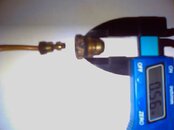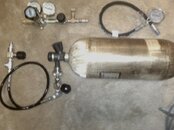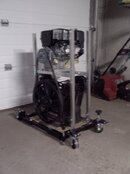Batt
Registered
I got a drain plug installed (will get a 5000psi drain valve later), found synthetic oil for it, found a suitable flywheel belt, and measured some fittings on the back which appear to be British Standard BSPT.
Bought a $15 2" 2000psi gauge to measure interstage pressure if needed later, but I'll have to order a compression fitting to connect 1/4"NPT male gauge to the 1/8: copper tubing.
Will buy a $15 2" 5000psi gauge to measure output final pressure, and run compressor tomorrow.
Windyairman, below is a photo of the 1/'8"copper I mentioned.
Frogman62, I think the compressor final output port is 1/4"NPT and I can connect a 5000psi gauge tomorrow. Can you give me more info on the military canister-style filter you mentioned, like what (Grade D?) air quality it produces, or if I can refill it myself or order replacement filters. I'll buy that as long as I can get replacement filters/refill it somewhere. I checked High Pressure Air Compressors - North Shore Compressor - Home which is not far, and they might have the filters.
Bought a $15 2" 2000psi gauge to measure interstage pressure if needed later, but I'll have to order a compression fitting to connect 1/4"NPT male gauge to the 1/8: copper tubing.
Will buy a $15 2" 5000psi gauge to measure output final pressure, and run compressor tomorrow.
Windyairman, below is a photo of the 1/'8"copper I mentioned.
Frogman62, I think the compressor final output port is 1/4"NPT and I can connect a 5000psi gauge tomorrow. Can you give me more info on the military canister-style filter you mentioned, like what (Grade D?) air quality it produces, or if I can refill it myself or order replacement filters. I'll buy that as long as I can get replacement filters/refill it somewhere. I checked High Pressure Air Compressors - North Shore Compressor - Home which is not far, and they might have the filters.






